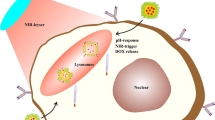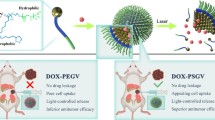Abstract
Gold nanorods (AuNRs) are usually synthesized using cetyltrimethylammonium bromide (CTAB) surfactant as a structure-directing agent. CTAB is reported to form a tightly bound cationic bilayer on AuNR surface with the cationic trimethylammonium head group exposed to the aqueous media. However, CTAB is also known to be highly toxic in both in vitro and in vivo experiments. In this work, we investigated the cytotoxicity, colloidal stability and optical properties of AuNRs before and after substitution with thiol-terminated triblock copolymer of ethylene oxide-propylene oxide (PEO-PPO-PEO), or Pluronic F127® (PF127). For that, PF127 was first chemically functionalized with 3-mercaptopropionic acid (MPA) and further used as stabilizer for the AuNRs by replacing CTAB molecules. Unmodified PF127 was also tested and used as a control for biological experiments. Morphology of coated AuNRs was characterized by visible spectroscopy, transmission electron microscopy, zeta potential, and dynamic light scattering. We found that coating with PF127-SH guarantees both stability and biocompatibility of AuNRs for at least 45 days, besides improving cell viability when compared to the PF127-coated AuNRs, even after 72 h treatment. In addition, this new polymer coating can also provide hydrophobic domains assembled into the PPO blocks, which could be further loaded with organic active ingredients. The obtained results show the potential of this nanostructured system for future developments in multifunctional nanoplataforms for clinical applications such as drug delivery, hyperthermia, photodynamic therapy, and diagnostic imaging of cells and tissues.










Similar content being viewed by others
References
Jian Z, Yong-Chang W, Shi-Nong Y, Yi-min L (2003) Electrochemical synthesis and absorption properties of gold nanorods. J Wuhan Univ Technol Sci Ed 18:6–9. https://doi.org/10.1007/BF02838378
Dickerson EB, Dreaden EC, Huang X, el-Sayed IH, Chu H, Pushpanketh S, McDonald JF, el-Sayed MA (2008) Gold nanorod assisted near-infrared plasmonic photothermal therapy (PPTT) of squamous cell carcinoma in mice. Cancer Lett 269:57–66. https://doi.org/10.1016/j.canlet.2008.04.026
Zijlstra P, Chon JWM, Gu M (2009) Five-dimensional optical recording mediated by surface plasmons in gold nanorods. Nature 459:410–413. https://doi.org/10.1038/nature08053
Vonnemann J, Beziere N, Böttcher C, Riese SB, Kuehne C, Dernedde J, Licha K, von Schacky C, Kosanke Y, Kimm M, Meier R, Ntziachristos V, Haag R (2014) Polyglycerolsulfate functionalized gold nanorods as optoacoustic signal nanoamplifiers for in vivo bioimaging of rheumatoid arthritis. Theranostics 4:629–641. https://doi.org/10.7150/thno.8518
Huang X, Neretina S, El-Sayed MA (2009) Gold nanorods: from synthesis and properties to biological and biomedical applications. Adv Mater 21:4880–4910. https://doi.org/10.1002/adma.200802789
Lippok N, Villiger M, Albanese A, Meijer EFJ, Chung K, Padera TP, Bhatia SN, Bouma BE (2017) Depolarization signatures map gold nanorods within biological tissue. Nat Photonics 11:583–588. https://doi.org/10.1038/nphoton.2017.128
Muddineti OS, Ghosh B, Biswas S (2015) Current trends in using polymer coated gold nanoparticles for cancer therapy. Int J Pharm 484:252–267. https://doi.org/10.1016/j.ijpharm.2015.02.038
Eustis S, El-Sayed MA (2006) Why gold nanoparticles are more precious than pretty gold: noble metal surface plasmon resonance and its enhancement of the radiative and nonradiative properties of nanocrystals of different shapes. Chem Soc Rev 35:209–217. https://doi.org/10.1039/B514191E
Alkilany AM, Thompson LB, Boulos SP, Sisco PN, Murphy CJ (2012) Gold nanorods: their potential for photothermal therapeutics and drug delivery, tempered by the complexity of their biological interactions. Adv Drug Deliv Rev 64:190–199. https://doi.org/10.1016/j.addr.2011.03.005
Helmchen F, Denk W (2005) Deep tissue two-photon microscopy. Nat Methods 2:932–940. https://doi.org/10.1038/nmeth818
Weissleder R (2001) A clearer vision for in vivo imaging. Nat Biotechnol 19:316–317. https://doi.org/10.1038/86684
Franklin Kim, Jae Hee Song A, Yang P (2002) Photochemical synthesis of gold nanorods. J Am Chem Soc 124:14316–14317. https://doi.org/10.1021/JA028110O
Pérez-Juste J, Liz-Marzán LM, Carnie S, Chan DYC, Mulvaney P (2004) Electric-field-directed growth of gold nanorods in aqueous surfactant solutions. Adv Funct Mater 14:571–579. https://doi.org/10.1002/adfm.200305068
Pérez-Juste J, Pastoriza Santos I, Liz Marzan L, Mulvaney P (2005) Gold nanorods: synthesis, characterization and applications. Coord Chem Rev 249:1870–1901. https://doi.org/10.1016/j.ccr.2005.01.030
Nikoobakht B, El-Sayed MA (2003) Preparation and growth mechanism of gold nanorods (NRs) using seed-mediated growth method. Chem Mater 15:1957–1962. https://doi.org/10.1021/cm020732l
Murphy CJ, Thompson LB, Chernak DJ, Yang JA, Sivapalan ST, Boulos SP, Huang J, Alkilany AM, Sisco PN (2011) Gold nanorod crystal growth: from seed-mediated synthesis to nanoscale sculpting. ☆ Colloid Interface Sci 16:128–134. https://doi.org/10.1016/j.cocis.2011.01.001
Il CW, Sahu A, Kim YH, Tae G (2012) Photothermal cancer therapy and imaging based on gold nanorods. Ann Biomed Eng 40:534–546. https://doi.org/10.1007/s10439-011-0388-0
Alkilany AM, Nagaria PK, Hexel CR, Shaw TJ, Murphy CJ, Wyatt MD (2009) Cellular uptake and cytotoxicity of gold nanorods: molecular origin of cytotoxicity and surface effects. Small 5:701–708. https://doi.org/10.1002/smll.200801546
Taylor J, Huefner A, Li L, Wingfield J, Mahajan S (2016) Nanoparticles and intracellular applications of surface-enhanced Raman spectroscopy. Analyst 141:5037–5055. https://doi.org/10.1039/C6AN01003B
Qiu Y, Liu Y, Wang L, Xu L, Bai R, Ji Y, Wu X, Zhao Y, Li Y, Chen C (2010) Surface chemistry and aspect ratio mediated cellular uptake of au nanorods. Biomaterials 31:7606–7619. https://doi.org/10.1016/j.biomaterials.2010.06.051
Rayavarapu RG, Petersen W, Hartsuiker L, Chin P, Janssen H, van Leeuwen FWB, Otto C, Manohar S, van Leeuwen TG (2010) In vitro toxicity studies of polymer-coated gold nanorods. Nanotechnology 21:145101. https://doi.org/10.1088/0957-4484/21/14/145101
Goh D, Gong T, Dinish US, Maiti KK, Fu CY, Yong KT, Olivo M (2012) Pluronic triblock copolymer encapsulated gold nanorods as biocompatible localized plasmon resonance-enhanced scattering probes for dark-field imaging of cancer cells. Plasmonics 7:595–601. https://doi.org/10.1007/s11468-012-9347-3
Burrows ND, Lin W, Hinman JG, Dennison JM, Vartanian AM, Abadeer NS, Grzincic EM, Jacob LM, Li J, Murphy CJ (2016) Surface chemistry of gold nanorods. Langmuir 32:9905–9921. https://doi.org/10.1021/acs.langmuir.6b02706
von Maltzahn G, Park J-H, Agrawal A, Bandaru NK, Das SK, Sailor MJ, Bhatia SN (2009) Computationally guided photothermal tumor therapy using long-circulating gold nanorod antennas. Cancer Res 69:3892–3900. https://doi.org/10.1158/0008-5472.CAN-08-4242
Qin Z, Wang Y, Randrianalisoa J, Raeesi V, Chan WCW, Lipiński W, Bischof JC (2016) Quantitative comparison of photothermal heat generation between gold nanospheres and nanorods. Sci Rep 6(29836). https://doi.org/10.1038/srep29836
Diniz IMA, Chen C, Xu X, Ansari S, Zadeh HH, Marques MM, Shi S, Moshaverinia A (2015) Pluronic F-127 hydrogel as a promising scaffold for encapsulation of dental-derived mesenchymal stem cells. J Mater Sci 26(153):153. https://doi.org/10.1007/s10856-015-5493-4
Guo X, Wang L, Wei X, Zhou S (2016) Polymer-based drug delivery systems for cancer treatment. J Polym Sci 54:3525–3550. https://doi.org/10.1002/pola.28252
Mosmann T (1983) Rapid colorimetric assay for cellular growth and survival: application to proliferation and cytotoxicity assays. J Immunol Methods 65:55–63
Freshney RI (2005) Basic principles of cell culture. Wiley, Hoboken
Schuetze B, Mayer C, Loza K, Gocyla M, Heggen M, Epple M (2016) Conjugation of thiol-terminated molecules to ultrasmall 2 nm-gold nanoparticles leads to remarkably complex 1 H-NMR spectra. J Mater Chem B 4:2179–2189. https://doi.org/10.1039/C5TB02443A
Redouan Mahou, Christine Wandrey, (2012) Versatile Route to Synthesize Heterobifunctional Poly(ethylene glycol) of Variable Functionality for Subsequent Pegylation. Polymers 4(1):561–589
Silverstein RM, Robert M, Webster FX, Kiemle DJ, Bryce DL, David L (2014) Spectrometric identification of organic compounds. Wiley, Hoboken
Murphy CJ, Sau TK, Gole AM, Orendorff CJ, Gao J, Gou L, Hunyadi SE, Li T (2005) Anisotropic metal nanoparticles: synthesis, assembly, and optical applications. J Phys Chem B 109:13857–13870. https://doi.org/10.1021/jp0516846
Gómez-Graña S, Hubert F, Testard F, Guerrero-Martínez A, Grillo I, Liz-Marzán LM, Spalla O (2012) Surfactant (bi)layers on gold nanorods. Langmuir 28:1453–1459. https://doi.org/10.1021/la203451p
Murphy CJ, Thompson LB, Alkilany AM, Sisco PN, Boulos SP, Sivapalan ST, Yang JA, Chernak DJ, Huang J (2010) The many faces of gold nanorods. J Phys Chem Lett 1:2867–2875. https://doi.org/10.1021/jz100992x
Gong T, Goh D, Olivo M, Yong K-T (2014) In vitro toxicity and bioimaging studies of gold nanorods formulations coated with biofunctional thiol-PEG molecules and pluronic block copolymers. Beilstein J Nanotechnol 5:546–553. https://doi.org/10.3762/bjnano.5.64
Scotti A, Liu W, Hyatt JS, Herman ES, Choi HS, Kim JW, Lyon LA, Gasser U, Fernandez-Nieves A (2015) The CONTIN algorithm and its application to determine the size distribution of microgel suspensions. J Chem Phys 142:234905. https://doi.org/10.1063/1.4921686
Acknowledgements
The Brazilian Coordination for the Improvement of Higher Education Personnel (CAPES, Brazil) and National Council for Scientific and Technological Development (CNPq, Brazil) provided financial support for this work. The authors wish to thank LABNANO/CBPF where the electron microscopy was performed.
Author information
Authors and Affiliations
Corresponding author
Ethics declarations
Conflict of interest
The authors declare that they have no conflict of interest.
Additional information
Publisher’s note
Springer Nature remains neutral with regard to jurisdictional claims in published maps and institutional affiliations.
Electronic supplementary material
ESM 1
(PDF 264 kb)
Rights and permissions
About this article
Cite this article
Zanetti, M.R.L., Percebom, A.M., Ribeiro, T.A. et al. Improving in vitro biocompatibility of gold nanorods with thiol-terminated triblock copolymer. Colloid Polym Sci 297, 1477–1487 (2019). https://doi.org/10.1007/s00396-019-04553-y
Received:
Revised:
Accepted:
Published:
Issue Date:
DOI: https://doi.org/10.1007/s00396-019-04553-y




